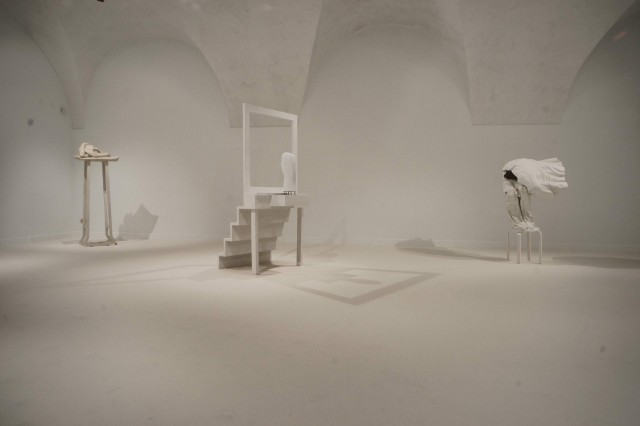KRZYSZTOF SOŁOWIEJ Sculptures
Opening: 17.01.2014, opening hour: 18.00
Open until: 28.02.2014, opening hours: Mon-Sat 12.00-18.00

(…)
When we look at Krzysztof Sołowiej’s sculptures/objects, we are always struck by his care and impeccable artistry. There is no casualty at the level of performance and formal solutions; colours and compositions are sophisticated and precisely thought out. However, it has to be emphasized that his attachment to artistry serves mainly the purpose of creating and conveying his personal stories in the most clear and apt way. It is like a true ‘good morning’ to a viewer, but its purpose is to focus attention on the contents which a given image can evoke. Sołowiej is one of a few contemporary artists who uses aesthetics and artistry in a way conscious of its meaning and simultaneously of its limitations. It refers to a visual image, the area of major importance for the perception of the world and, at the same time, seriously impoverished and trivialized. His attachment to traditional artistry seems to be an attitude hardly encountered nowadays. The majority of artists looks for other ways of practicing art, many a time employing words as an instrument which assists them in justifying their art. Words as justification for art and a substitute for artistry often causes disorientation and makes its sensible verification truly difficult. Excessive trust in its power and precision while forgetting about its barriers is even a form of a betrayal of the competence of visual arts. What’s worse, it can make a visual layer empty and in principle unnecessary, reducing it to a level of unconvincing aesthetics. In Sołowiej’s works words and descriptions are always of a secondary significance and are not indispensable in understanding them as they never illustrate the ideas which had been formed and then verbalized. His oeuvre reminds us about the source of art, perceptible world, discernible by means of senses.
Another issue that we should turn our attention to is a variety of the materials used by the artist. Apart from the usual materials like wood, clay or stone, the artist uses completely astonishing substances: bottle caps, tracing paper, resin as well as ready-made elements: little plastic figures, lamps, ceramic, pop culture gadgets etc. However, they are never indifferent materials, used without knowledge concerning their symbolic and cultural references. Let us have a closer look at how tracing paper which relates to the idea of soul/spirit was used in the work “a half-boy’, the memory of a tree growth in the sculpture ‘a secret of double pleasure’ or the grotesque humour of the sound gadget in the object ‘an oriental code’. The artist remembers that everything can be a material for making art, and knows perfectly that only the transformation of various substances within the scheme of new orders attributes new meanings to them and allows entering into the worlds of unobvious meanings. In order for it to happen matter which is to be used has to be transformed and become a new quality.
(…)
It is difficult to subject Krzysztof Sołowiej’s oeuvre to simple categories. Among many desires shared by artists there is a need to find one’s own, unique and, at the same time, recognizable language. There are not too many who succeed in it, and it is the case of Sołowiej’s art which is so individual and free from being loaded with too many references. It is worth stoping and have a look at it. Being so complex, it is very dynamic and active. It is created by the artist who takes full responsibility for what he does, without imposing it onto a viewer and leaving a vast field for interpretation. The trace which he leaves imprinted in us is a reflection of his extraordinary imagination and skills, offering us a rare chance to open the closed or forgotten recesses of our mind. The artist’s sculptures/objects can be a catalyst for investigations and individual private worlds. Let us try to move into the land of fantasy in which we can move around. (…)
Dariusz Głowacki
Tr. Małgorzata Sady



















































